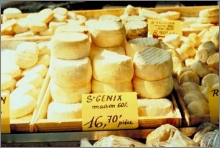The Six Healthiest Staple Foods in French Cuisine
by www.SixWise.com
French food and healthy food do not always ring synonymous to many people's ears. Quite the contrary, French food is known for its rich (i.e. fat-filled) sauces, heavy use of butter, decadent pastries, lots of fresh, crusty bread and generous servings of red wine.
|

French food is not all about pastries and wine. They also revolve their meals around fresh, locally grown, in-season vegetables.
|
Yet, this doesn't necessarily make it unhealthy. Perhaps you've heard of the so-called "French Paradox" -- the very real notion that French people eat everything "forbidden" yet are far thinner than their American counterparts.
There are a number of reasons why this may be. For instance, last year a study in Obesity found that French people tend to rely on internal cues (such as no longer feeling hungry) to tell them when to stop eating, while Americans use external cues (when their plate is empty or when the TV program is over).
Meanwhile, the French culture revolves around fresh, high-quality food. People still shop at small local markets, picking out fresh foods to cook that day's meals. Fast-food is the exception rather than the rule, and although they do eat calorie-rich foods, they do so in moderation. In this way, French cuisine is arguably much healthier than most Americanized, processed food.
That said, let's take a look at some of the healthiest staple foods commonly used in French cuisine.
1. Butter
Butter, a key ingredient in French sauces, pastries and meals in general, is typically shunned in the United States because of its high saturated fat content, but according to some experts, including those at the Weston A. Price Foundation, saturated fats are actually good for you. Here they describe the many roles of saturated fats:
"Contrary to the accepted view, which is not scientifically based, saturated fats do not clog arteries or cause heart disease. In fact, the preferred food for the heart is saturated fat; and saturated fats lower a substance called Lp(a), which is a very accurate marker for proneness to heart disease.
Saturated fats play many important roles in the body chemistry. They strengthen the immune system and are involved in inter-cellular communication, which means they protect us against cancer. They help the receptors on our cell membranes work properly, including receptors for insulin, thereby protecting us against diabetes. The lungs cannot function without saturated fats, which is why children given butter and full-fat milk have much less asthma than children given reduced-fat milk and margarine. Saturated fats are also involved in kidney function and hormone production.
|

Looking for a healthy way to indulge in French desserts? Gluten-Free French Desserts And Baked Goods has over 100 irresistible French recipes for breads, tarts, cakes, puddings, custards, crêpes, cookies, brownies, and bars -- all made with gluten-free ingredients!
|
Saturated fats are required for the nervous system to function properly, and over half the fat in the brain is saturated. Saturated fats also help suppress inflammation. Finally, saturated animal fats carry the vital fat-soluble vitamins A, D and K2, which we we need in large amounts to be healthy.
Human beings have been consuming saturated fats from animals products, milk products and the tropical oils for thousands of years; it is the advent of modern processed vegetable oil that is associated with the epidemic of modern degenerative disease, not the consumption of saturated fats."
Butter is also rich in antioxidants and other nutrients including vitamin A, vitamin E, selenium and cancer-fighting conjugated linoleic acid.
2. Red Wine
Some of the most popular French dishes -- coq au vin (chicken in red wine), beef bourguignonne, and many others -- depend on red wine for their flavor.
Red wine is one of the healthiest forms of alcoholic beverages there is. It contains an antioxidant known as resveratrol (it's in grape skins and red wine.) Resveratrol belongs to the polyphenol family, which are known to fight the effects of damaging free radicals. Along with fighting free radicals, resveratrol reduces the risk of heart disease and cancer and may one day be used to extend lifespan in humans-already studies have found that it can extend the lifespan of yeast cells by up to 80 percent.
While the French do enjoy red wine with their meals, if you're worried about the alcohol use wine only in your cooking -- the heat causes the alcohol to evaporate, leaving only the rich flavor behind.
3. Summer Savory
A popular herb in French cuisine, savory has a long history of medicinal use that dates back to ancient Rome. It's been used for everything from bee stings to flatulence to promoting health during pregnancy. It's even said to be an aphrodisiac.
Savory is a member of the mint family and has a peppery flavor with mint and thyme undertones. Use it to enhance the flavor of fish, vegetables (particularly tomatoes and tomato sauce), cheese, eggs, pea soups and beans.
4. Onions and Shallots
Onions and their milder cousins shallots are used in countless French dishes. Shallots are particularly popular cooked with wine, carmelized or roasted, and they have a flavor similar to onions but less harsh.
Health-wise, onions contain quercetin, a powerful anti-oxidant that is also a natural anti-histamine, and anti-inflammatory. They also contain the sulfur compounds allicin and diallyl disulphide (DADS) (which are also found in leeks and chives). These compounds help to induce the relaxation and enlargement of blood vessels, which improves blood flow throughout the body.
|

Another mainstay of French cuisine? Cheese, which is often served as a separate course.
|
5. Dijon Mustard
Named for the city Dijon, Dijon mustard originated in France where it was first made by Jean Naigeon in 1752. Instead of the vinegar used today, Naigeon combined mustard seeds with verjuice (the sour juice of unripe grapes) to make a smoother mustard that had never before existed. Today Dijon mustard is used to make vinaigrettes, soups, sauces, marinades and more.
Mustard seeds are actually very healthy, as they belong to the incredibly healthy cruciferous plant family. Aside from being an excellent source of selenium, mustard seeds contain phytonutrient compounds that protect against gastrointestinal cancer.
6. Olive Oil
Though typically associated with Italian cuisine, certain areas of France, specifically the French Mediterranean, use olive oil in lieu of butter in many of their dishes. Olive oil is well known for its healthy properties, which include antioxidants, polyphenols, flavonoids and vitamin E. This combination has been found to help fight colon cancer and heart disease, as well as reduce inflammation.
Delicious French Recipes!
If all of this talk about French cuisine has got your mouth watering, you're in luck. Here are two delectable recipes you can try out right now.
Truffled Onion Soup
Ingredients:
- 1/2 lb onions, finely sliced
- 3 Tbsp butter
- 2 tsp flour
- 1 quart beef broth
- 2 fl oz whipping cream
- 0.9 oz black winter truffles
- Salt and pepper
- 2 Tbsp grated parmesan
Method:
- Heat the butter in a saucepan; add the onions and cook very gently over low heat until the onions are very soft. Do not allow to burn.
- When the onions are light-brown, sprinkle with the flour and cook for 2 minutes, stirring constantly, until the flour turns light-brown.
- Add the broth, stirring to avoid any lump and cook for 30 minutes over low heat.
- Meanwhile, pour the whipping cream in a small cup, grate the truffle (or cut it in very small pieces), add the truffles to the cream, cover with plastic wrap and set aside while the soup is cooking.
- Check the seasoning of the soup, add the truffles and the cream, stir and pour into 4 warmed bowls. Sprinkle with the grated parmesan.
Serves 4
Recipe from FrenchSelections.com
Chicken in Red Wine (Coq au Vin)
Ingredients:
- 1 chicken (about 3 lbs), cut up
- 6 tbsp butter
- Salt and pepper
- 6 oz lean bacon slab, cut into lardons
- 18 pearl onions, peeled
- 2 tbsp Cognac (or other Brandy)
- 1 bottle of red wine
- 1 garlic clove, peeled
- 1 bouquet garni
- 1 tbsp flour
- Chopped fresh parsley
Method:
- Heat 4 tbsp of the butter in a flameproof casserole over medium heat. Add the chicken pieces, season with salt and pepper and brown the chicken on all sides.
- Meanwhile, put the lardons in a saucepan and cover with cold water; bring to a boil and blanch for 5 minutes. Drain and reserve.
- Remove the pieces of chicken and set aside.
- Put the bacon and onions in the casserole; cook for 10 minutes, stirring frequently.
- Return the chicken to the casserole and add the Cognac. Heat and set alight. After the flames have died out, add the red wine, the garlic and the bouquet garni. Cover and simmer for 1 hour.
- About 15 minutes before the end of the cooking time, work 2 tbsp of softened butter with the flour to form a paste. Mix 2 tbsp of hot sauce into the butter and flour, return the mixture to the pot and stir well.
- Check seasoning and transfer to a warm serving dish. Garnish with soft parsley.
Serves 6
Recipe from FrenchSelections.com
Recommended Reading
Which Type of Bread is Healthiest ... and Which is SUPRISINGLY Least Healthy?
The 6 Healthiest Staple Foods in German Cuisine
Sources
The Weston A. Price Foundation, Why Butter is Better
Eurek Alert February 15, 2008
Suite101.com